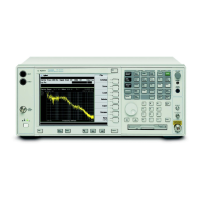The Pole-Residue (Partial Fraction) Format
The pole-residue form of the LaPlace variable is most commonly used to
describe mechanical resonances. For pole-residue data, the synthesis table is
split into two columns: the left side for poles and the right side for residues. A
residue is another name for the numerator constant for each pole term in the
partial-fraction expansion.
Poles can be simple (real) or entered as a complex conjugate pair. A pole and
its residue are always on the same line in the synthesis table (unlike pole-zero
tables, where order doesn’t matter). Α ±jΒ distinguishes a complex conjugate
pole-pair from a simple pole.
Since a complex conjugate pole-pair corresponds to two terms in a
partial-fraction expansion, the residue is also interpreted as being a
complex-conjugate pair.
For pole-residue data, the synthesis table can contain up to 20 lines of simple
poles and simple residues. However, if the table is composed of all
complex-conjugate pairs, it can only consist of a maximum of 10 lines.
ThePole-ResidueEquation
To express your transfer function in pole-residue format, use the following
formula:
where:
* is the conjugate
KisthesystemGain
P are the pole positions
A are the residues (a constant, possibly complex)
c terms caused by numerator order ≥ denominator order
This formula is the basis for interpreting pole-residue data in the synthesis
table. Pole positions are in Hertz. During synthesis, the analyzer replaces s
with jf (where f is frequency in Hertz). If the same pole (real or conjugate) is
entered more than once, the pole term is surrounded by parenthesis and its
order is indicated by ^n, where n is the multiplicity. There are no c terms if the
numerator order is less than the denominator order.
Hs K cs cs
af
=+++[...12
01
A
sP
A
sP
A
sP
A
sP
A
sP
A
sP
A
sP
1
1
2
2
2
2
3
3
3
3
4
3
4
3
22
()()( )()( )()( )
...]
*
*
*
*
*
*
−
+
−
+
−
+
−
+
−
+
−
+
−
+
Agilent 35670A
Synthesis Option 1D3 Operator's Guide
15-6
